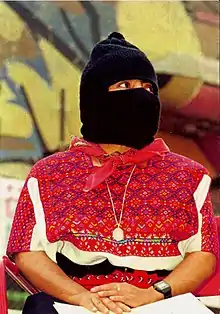Comandanta Ramona
Comandanta Ramona (1959 – 6 January 2006) was an officer of the Zapatista Army of National Liberation (EZLN), a revolutionary indigenous autonomist organization based in the southern Mexican state of Chiapas. She led the Zapatista Army into San Cristóbal de las Casas during the Zapatista uprising of 1994, and was the first Zapatista to appear publicly in Mexico City.[1][2][3]
Comandanta Ramona | |
|---|---|
 | |
| Born | 1959 Chiapas, Mexico |
| Died | 6 January 2006 (aged 46–47) |
| Occupation | Revolutionary |
Biography
Ramona was born in 1959 in a Tzotzil Maya community in the highlands of Chiapas, Mexico.[4][5] Ramona used to sell handmade goods to make a poor living before she joined the EZLN.[6]
By the 1990s, Ramona was a women's rights activist, and helped to draw up a 'Revolutionary Law on Women' through consulting with women in indigenous communities. This called for access to power in decision making, free choice of a spouse, an end to domestic abuse and access to health care.[1][2]
Ramona took control of the city of San Cristóbal de las Casas, the former capital of Chiapas, on 1 January 1994 during the Zapatista uprising. She was one of the seven women comandantas of the Zapatistas, and around one-third of the Zapatista army were women.[6] After the rebellion ended, she remained in the Lacandon Jungle with Subcomandante Marcos to apply political pressure on the Mexican government.[2]
In February 1994, Ramona was sent to the peace talks with the government in San Cristóbal's cathedral.[2]
In 1996, she traveled to Mexico City to help found the National Indigenous Congress, despite a government ban. Zapatista sympathisers surrounded her to prevent her arrest. She also addressed a crowd of 100,000 in the central plaza, highlighting the lack of a hospital in San Andrés de Larrainzer and that this meant indigenous people had to travel for 12 hours to get treatment.[7][2][6]
Health and death
By 1996, Ramona was seriously ill with kidney failure, and was granted immunity to travel to receive a kidney transplant from her brother.[1][6] She died on 6 January 2006 of kidney failure.[2]
Legacy
Ramona was famous for being masked and wearing traditional Indigenous clothing. Vendors in her hometown created doll replicas of Ramona in her honor, wearing traditional costume, a mask and carrying a gun.[6][1]
Ramona appeared in the 1996 film The Sixth Sun: Mayan Uprising in Chiapas.[8]
Ramona had campaigned for access to medical treatment: a Zapatista health clinic in La Garrucha is now named the Comandanta Ramona after her.[9]
See also
References
- Zwarenstein, Carlyn (11 January 2006). "Legacy of a Zapatista Rebel". The Globe and Mail. p. 19.
- Davison, Phil (9 January 2006). "Comandante Ramona". The Independent. Retrieved 23 November 2015.
- "Zapatista leader Ramona dies". Al Jazeera. 7 January 2006. Retrieved 9 June 2023.
- Queen of the Neighbourhood Collective (2010). Revolutionary Women: A Book of Stencils. Oakland, California: PM Press. p. 99. ISBN 978-1604862003.
- Amozurrutia, Alina (2008). 101 Mujeres en la Historia de México (in Spanish). Mexico City: Grijalbo. p. 301. ISBN 978-9708103282.
- Wolfwood, Terry (August 1997). "Who Is Comandanta Ramona?" (PDF). Third World Resurgence. No. 84. Retrieved 20 November 2015.
- Ross, John (17 March 1999). "The Zapatistas are Back". LA Weekly. Retrieved 22 September 2023.
- Saul Landau (April 1997). The Sixth Sun: Mayan Uprising in Chiapas. Round Whirled Records. Retrieved 9 June 2023.
- Hesketh, Chris (2013). "The Clash of Spatializations: Geopolitics and Class Struggles in Southern Mexico". Latin American Perspectives. 40 (4): 70–87. doi:10.1177/0094582X12469603. ISSN 0094-582X. JSTOR 23465977. S2CID 145341846. Retrieved 9 June 2023.